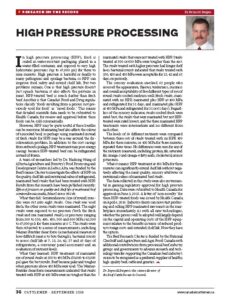High Pressure Processing
This article written by Dr. Reynold Bergen, BCRC Science Director, originally appeared in the September 2016 issue of Canadian Cattlemen magazine and is reprinted on the BCRC Blog with permission of the publisher.

In high pressure processing (HPP), food is sealed in water-resistant packaging, placed in a water-filled container, and exposed to very high hydrostatic pressures (up to 87,000 psi) for three to nine minutes. High pressure is harmful or deadly to many pathogenic and spoilage bacteria, so HPP can improve food safety and extend shelf life. But two problems remain. One is that high pressure doesn’t just squash bacteria; it also affects the proteins in meat. HPP-treated beef is much darker than fresh beef. Another is that Canada’s Food and Drug regulations classify “foods resulting from a process not previously used for food” as “novel foods.” This means that detailed scientific data needs to be submitted to Health Canada for review and approval before these foods can be sold commercially.
However, HPP may be quite useful if these hurdles can be overcome. Marinating beef also affects the colour of uncooked beef, so perhaps using marinated instead of fresh steaks for HPP may be a way around the discolouration problem. In addition to the cost savings from reduced spoilage, HPP treatment may pose energy savings because HPP-treated beef can be refrigerated instead of frozen.
A team of researchers led by Dr. Haihong Wang of Alberta Agriculture and Forestry’s Food Processing and Development Centre in Leduc, Alta. was funded by the Beef Science Cluster to investigate the effects of HPP on the quality, shelf life and nutritional value of refrigerated, marinated beef steaks that had been treated with HPP. Results from this research have been published recently: Effect of pressure on quality and shelf life of marinated beef semitendinosus steaks, Meat Science 99:148.
What they did
Semitendinosus (eye of round) muscles were cut into eight steaks. One steak was used fresh; the other seven steaks were marinated. The eight steaks were exposed to no pressure (both the fresh steak and one marinated steak), or pressures ranging from 300 to 350, 400, 450, 500 and 600 MPa (43,500 to 87,000 psi) for three minutes at 8°C. The steaks were then subjected to a series of measurements, including Warner-Bratzler shear force (a mechanical measure of how difficult meat is to bite through), bacterial counts to assess shelf life at 7, 15, 28, 42, 57 and 85 days of refrigeration, a consumer panel assessment and an evaluation of nutrient levels.
What they learned
HPP treatment of marinated eye of round steaks at 350 to 450 MPa (50,000 to 65,000 psi) gave the best results. Beef became paler and tougher when pressures above 450 MPa were used. The WarnerBratzler shear force measurements indicated that steaks treated with HPP at 450 MPa were no tougher than the marinated steaks that were not treated with HPP. Steaks treated at 500 or 600 MPa were tougher than the rest. The steaks treated with higher pressures had longer shelf lives; bacterial counts indicated that steaks treated with 350, 400 and 450 MPa were acceptable for 15, 42 and 85 days, respectively.
The sensory evaluation involved 85 people who assessed the appearance, flavour, tenderness, juiciness and overall acceptability of five different types of eye of round steaks cooked medium-well (fresh steaks, marinated with no HPP, marinated plus HPP at 400 MPa and refrigerated for 31 days, and marinated plus HPP at 450 MPa and refrigerated for 31 or 61 days). Regardless of the sensory indicator, steaks cooked fresh were rated best, the steaks that were marinated but not HPP-treated were rated lowest, and the three marinated HPP treatments were intermediate and no different from each other.
The levels of 30 different nutrients were compared between three sets of steaks treated with no HPP, 450 MPa for three minutes, or 450 MPa for three minutes, repeated three times. No differences were seen for any of the nutrients measured, including protein, fat, saturated fat, omega-3 and omega-6 fatty acids, cholesterol, iron or potassium.
What it means
HPP treatment at 450 MPa for three minutes can significantly extend shelf life without negatively affecting the meat quality, sensory attributes or nutritional values of marinated beef steaks.
The data collected in this study were also instrumental in gaining regulatory approval for high pressure processing. Data were submitted to Health Canada for approval on June 3, 2015. A letter of “non-novelty” for these HPP-treated foods was issued by Health Canada on April 8, 2016. Industry clients can now start producing and selling HPP marinated raw meats in the marketplace immediately.
As with all new technologies, whether the process will be adopted will largely depend on the capital and operating costs of the HPP equipment relative to the benefits in terms of reduced product storage costs and extended shelf life.
Now they have the option.
Click here to subscribe to the BCRC Blog and receive email notifications when new content is posted.
The sharing or reprinting of BCRC Blog articles is typically welcome and encouraged, however this article requires permission of the original publisher.
We welcome your questions, comments and suggestions. Contact us directly or generate public discussion by posting your thoughts below.